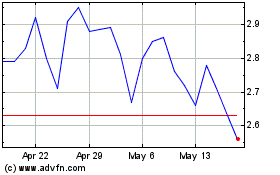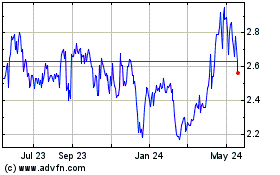Tech Alert: BrainChip Identifies Advantages to Radar and Lidar Systems Leveraging Event-Based AI
10 September 2024 - 5:00AM
Business Wire
Developers of radar and lidar systems have a new option in
addressing key detection and tracking challenges by utilizing
event-based AI computing architectures that provide performance
improvements over conventional signal processing algorithms, say
researchers at BrainChip Holdings Ltd (ASX: BRN, OTCQX: BRCHF, ADR:
BCHPY), the world’s first commercial producer of ultra-low power,
fully digital, event-based, brain-inspired AI.
Radar systems are used in industries beyond aviation and
military and are prevalent in automotive, robots, drones, and
anything with autonomous mobility. Similarly, lidar (light
detection and ranging) applications span settings like engineering,
energy, agriculture, and transportation, among others. The demand
for efficient, responsive, smaller and lower-power adaptable radar
and lidar technology is high as these industries increasingly rely
on AI/ML.
Event-based AI/ML represents an advancement in AI/ML technology,
capable of working efficiently with sequential or continuous data
streams, which represent the types of signals produced in radar and
lidar systems. Event-based computing is ideal for processing point
cloud solutions directly instead of preprocessing into 2D images
for traditional neural processing with convolutional neural
networks (CNNs) or recurrent neural networks (RNNs).
Event-based computing takes advantage of sparsity of networks
and data to only perform computations that impact final inference
results, producing more efficient network execution and utilization
of compute resources. Using new neural architectures that combine
spatial and temporal computations reduces the number of
computations needed compared to convolutional neural networks as
well. Most importantly, the event-based computations can improve
the detection and tracking characteristics of the radar.
Event-based computing, when widely adopted, has the promise to
improve speed, accuracy, and resource efficiency in radar/lidar
systems, with advantages including:
- Rapid, accurate response - Systems that use event-based
computing can rapidly detect and respond to signals and changes in
the environment, such as a moving object. More traditional systems
use sampling frames to collect and process data at regular
intervals, regardless of if there is a signal, a change, or an
activity, resulting in unnecessary computations and higher latency
until the next frame is processed.
- Power efficiency -Traditional compute systems are
constantly consuming power even when no significant events are
occurring. Event-based AI processing only computes when an event
occurs, so it requires far less energy to operate. Event-based
computing’s lower power consumption can extend the operational life
of radar/lidar systems in field deployments where sustained use is
required.
- Better data management - Radar and lidar systems are
data-intensive with much of the data redundant or not relevant to
the operation data. Traditional AI neural networks quickly get
bogged down processing this unnecessary data, causing latency and
delayed responses. Event-based computing focuses only on relevant
data, which vastly reduces data overload and eases storage.
- Size and scope - Applications in this category include
very small-scale systems, like gesture recognition and robotics, to
automotive radar that detects the sudden appearance of an object,
classifies it as a pedestrian, another vehicle or road obstacle,
and tracks it to estimate if it is on a collision path with the
vehicle. Traditional large-scale systems, like global weather
monitoring that tracks storms or air traffic control, often have
multi-channel antenna systems, which can also benefit from
event-based processing. Event-based processing is highly adaptable
and capable of improving outcomes in both small and large
environments or anywhere it is important to allocate resources
efficiently.
“Event-based AI processes only critical information, which
enables faster decision making and improved safety,” said Tony
Lewis, BrainChip CTO. “This temporal-enabled, neural-networking
model delivers improvements in detection accuracy, safety and
efficiency in radar/lidar systems.”
BrainChip’s AkidaTM is an event-based compute platform ideal for
early detection, low-latency solutions without massive compute
resources for robotics, drones, automotive and traditional
sense-detect-classify-track solutions. BrainChip provides a range
of software, hardware and IP products that can be integrated into
existing and future designs, with a roadmap for customers to deploy
multi-modal AI models at the edge.
To learn more: https://bit.ly/3ZjrExo
About BrainChip Holdings Ltd (ASX: BRN, OTCQX: BRCHF, ADR:
BCHPY)
BrainChip is the worldwide leader in Edge AI on-chip processing
and learning. The company’s first-to-market, fully digital,
event-based AI processor, AkidaTM, uses principles that mimic the
human brain, analyzing only essential sensor inputs at the point of
acquisition, processing data with unparalleled efficiency,
precision, and economy of energy. Akida uniquely enables Edge
learning local to the chip, independent of the cloud, dramatically
reducing latency while improving privacy and data security. Akida
Neural processor IP, which can be integrated into SoCs on any
process technology, has shown substantial benefits on today’s
workloads and networks, and offers a platform for developers to
create, tune and run their models using standard AI workflows like
Tensorflow/Keras. In enabling effective Edge compute to be
universally deployable across real world applications such as
connected cars, consumer electronics, and industrial IoT, BrainChip
is proving that on-chip AI, close to the sensor, is the future, for
its customers’ products, as well as the planet. Explore the
benefits of Akida at www.brainchip.com.
Follow BrainChip on Twitter:
https://www.twitter.com/BrainChip_inc Follow BrainChip on LinkedIn:
https://www.linkedin.com/company/7792006
View source
version on businesswire.com: https://www.businesswire.com/news/home/20240909268295/en/
Media Contact: Mark Smith JPR Communications
818-398-1424
Investor Relations: Tony Dawe Director, Global Investor
Relations tdawe@brainchip.com
Barnwell Industries (AMEX:BRN)
Historical Stock Chart
From Nov 2024 to Dec 2024

Barnwell Industries (AMEX:BRN)
Historical Stock Chart
From Dec 2023 to Dec 2024
